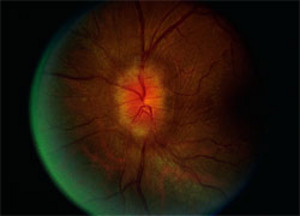Valentines Day – A day for love, relationships, flowers and candy. For me, being a practical mother of two, I did not want the more traditional gifts. All I wanted was a heart-felt “I love you” from my husband – and new glasses. My oldest son felt that my glasses needed vacuumed when he was two years old. So, I resorted to an older pair I had put back for a while. I also wore contacts, so this was not a major concern at the time. Six years later, February 2007, my contacts were gone and with a few unmentioned bills and expenses, I had not been able to make it to the eye doctor. But, this was just the beginning of my problems.
I had been having horrible headaches, not to mention pain and noise in my right ear. But, I thought my glasses were the cause of the headaches and I would take care of the assumed ear infection a little later. My (at least) ten year old glasses needed an upgrade. A quick call to the eye doctor landed an appointment for February 14, 2007. Perfect! What better Valentines gift could I have hoped for?
The morning of my appointment, I was awake at 4:00 AM. It seemed like I would never get back to sleep. I was actually excited about getting new glasses! Here I am, 26 years old, married with two young boys, and I felt like a kid on Christmas eve night. I got out of bed to use the restroom and when I flipped the light switch, the light did not come on. I yelled to my husband that the light bulb had blown, but he seemed more worried than I was annoyed. He told me that the light bulb had not blown and he could see the light coming on and going off each time I flipped the switch. This is when I traded my excitement for fear. I looked into the kitchen and I discovered that it, too, was dark. I was blind. The more frightened I got, the faster I flipped the bathroom light switch. Finally, I could see the light come on and go off. Still, I could not see any objects, only the difference of light and dark. I took a deep breath and flipped the switch a few more times. Slowly, I regained complete vision. I went back to bed to try to get some sleep before my appointment. I would be sure to tell the optometrist about this episode.
Later that morning, at the doctor’s office, I was explaining my blinding experience. Right away, the doctor asked me if I had ever had my eyes dilated. I never had, so he requested it done. Before long, I was sitting in a dark room with the distinct feeling that the numbing drops were working quite well. To be honest, my face was numb everywhere between my nose and eyebrows.
When the doctor came back in, he completed my exam. He said something I never expected to hear. “I think I see the source of your headaches.” Something told me he was not referring to my old glasses. He told me that my optic nerves were very swollen in both eyes. He continued with a few technical terms but one word stuck out. Pseudotumor. Pseudo… tumor? A tumor?! Okay, at this point, I was officially freaking out. He immediately sent me across the hall to be examined by ophthalmologist, Dr. Baker.
Dr. Baker confirmed the diagnosed pseudotumor cerebri (PTC). He went on to explain about this condition in its entirety. PTC is encountered most frequently in young, overweight women between the ages of 20 and 45. Headache is the most common presenting complaint, occurring in more than 90 percent of cases. Dizziness, nausea, and vomiting may also be encountered. Tinnitus, or a “rushing” sound in the ears, is another frequent complaint. PTC’s technical term is Idiopathic Intracranial Hypertension. It’s a condition of high pressure in the fluid around the brain. It is also known as pseudotumor cerebri because there are some of the signs and symptoms of a brain tumor without a brain tumor being present (pseudo meaning fake). The space around the brain is filled with a water-like fluid. If there is too much of this fluid present, (for example, if not enough being absorbed), the pressure around the brain rises. This is because the space containing the fluid cannot expand. It is this high pressure that produces the symptoms of idiopathic intracranial hypertension (idiopathic means unknown cause; intracranial means inside the head; hypertension means the fluid is under high pressure).
The next step was to rule out a brain tumor, so I was sent to the hospital for an MRI. During the MRI, I was injected with contrast so that the neurologist could see everything more clear inside my brain. The MRI took about 35 minutes and I was on my way home. I would not find out about the results until the next day. At this point, I did the only thing I could do – pray. I also called my family to let them know so they could be praying as well.
The next day, I was in Dr. Baker’s office once again, awaiting the results of my MRI. When he walked in, I was trying to read his body language. Maybe he would make a facial expression that would let me know the results before he actually read them. He was a blank slate. Sarcastically I thought, maybe he had done this before. He opened my file and as I held my breath, he said “You’re brain is normal.” I wanted to scream. I wanted to hug him. I wanted to do cart-wheels around the exam room. But, instead, I let out a sigh of relief and said a silent “Thank you.”
There isn’t really a “set-in-stone” cause for this condition, but there are a couple of red flags. As Dr. Baker pointed out in the explanation, this condition occurs mostly in young, overweight women between the ages of 20 and 45. It can also occur in women who have gained a significant amount of weight over a short period of time, or it can be caused by an overdose of vitamin A. The first step was to pin-point the reason I was having this complication. First off, I’m no health nut. The closest thing I had to vitamin A was a multi-vitamin I had been taking. So, the idea of an overdose was set aside. However, about a year before the headaches started, I had some pain in my lower stomach. Many doctor appointments later, I found out that I had ovarian cysts (among other things). Cutting the story short, I had a few operations to correct the problems. A little while later, back pain started. I was able to deal with it for a while, but sometimes the pain was so severe that I could barely walk to the restroom alone, let alone exercise. A few tests and an MRI later, I realize I have degenerative disk disease. Result? I gained about 40 pounds in approximately six months. Dr. Baker and I were certain that it was this weight gain that caused this, however, he instructed me to discontinue my multi-vitamin just in case. Instead, he wrote a prescription for Diamox, 250 milligrams, four times per day. Diamox is the leading diuretic that patients with this condition are given. Side effects are not normally severe and include tingling of hands and feet, nausea, headaches (in the beginning of treatment), ringing in the ears and they give soda a horrible metallic taste.
Although an ophthalmologist can diagnose PTC with “almost” 100% certainty, a lumbar puncture (spinal tap) is necessary to accurately check the pressure in the spine, diagnosing PTC for sure. A few days later, Dr. Baker sent me to neurologist Dr. Jones to discuss and schedule a spinal tap. Dr. Jones prescribed a higher dose of Diamox than Dr. Baker originally prescribed. He seemed to believe that a higher dose should be used to reduce the swelling faster. Instead of taking 1000 milligrams per day, I was now taking 2000 milligrams per day. This was getting serious. Needless to say, I was very nervous about this test. I had heard so many horror stories from friends and family who had this done before, but none of them came up with the same experience. They were all different, so I did not know what to expect. Against my will, I was admitted to Same Day Surgery for a lumbar puncture.
When they started the procedure, I was told to lie on my side so that the doctor could access my lower spine more easily. The nurse scrubbed my back and wiped it clean as the doctor entered the room. I felt sorry for this man. He was sure to be the most hated person in that hospital at that moment. He began by talking me through everything he was doing. First, it was the anesthesia. He told me that most patients call this “the bee sting.” The shot is given around the puncture area, and those other patients were not kidding! It definitely felt like a bee sting (or two!). After that was over, the lumbar puncture began. In my opinion, the anesthesia was worse than the actual lumbar puncture. During the procedure, a needle is inserted into the lower spine to check the pressure of the spinal fluid. They also withdraw fluid for testing. I felt a lot of pressure in my lower back, but nothing I would consider pain. The doctor asked me to move up farther on the table, and I will admit, moving while the needle was still inserted was somewhat painful. After the doctor was finished, I was instructed to roll from my left side, backwards, onto my bed to be wheeled back to my room. Bending or moving the spine or neck directly after a lumbar puncture can cause quite a few adverse effects, ranging anywhere from rupture or bleeding to a spinal headache. The nurse told me that the headaches I was having before were nothing compared to a spinal headache. I can not imagine that! The headaches I was having before left me weak and sometimes unable to speak properly. If the pain was worse than that, I just do not know how people survive that have had a spinal headache. God bless anyone who has! I was very careful not to do anything that would cause a headache like that. I rolled onto the bed, trying to keep my neck and spine in perfect alignment.
Once I arrived back in my room, the worst part began. Did you think the anesthesia was the worst part? Not at all. For four solid hours, I was told to lie on my back without moving. But, what if I had to pee? Can I watch TV? Can I do anything? I was like a child being told to sit still in church. At first, I was simply annoyed that I could not move. After the first 45 minutes to an hour, it was beginning to get painful. My back was hurting, my rear-end was numb and aching, and my legs were starting to fall asleep. After the two hour mark, yes you guessed it, I had to pee. Besides the fact they were making me drink juice to help replace any fluid that were withdrawn, I had been there for about five hours already without visiting the restroom. I tried to sleep as much as I could, just to pass the time. But, it seemed like the more I slept, the slower the clock went. Once, I think the minute hand actually went backwards! At 1pm, I was allowed to slowly sit up on the bed, and then stand, and walk to the restroom. As soon as I was able to get up and walk with no problems, I got dressed and was on my way home. The lumbar puncture test results showed elevated pressure within the fluid of my spine. Dr. Jones instructed me to continue taking Diamox and see my ophthalmologist regularly.
Since then, I have been eating right and “trying” to lose a little weight. I have lost about 13 pounds since this started. Do not let me pat myself on the back. That is not good. But, it is a start, nonetheless. With each appointment with the ophthalmologist, I come home with a dose of Diamox that is 250 milligrams less. Currently, I am back down to 1000 milligrams per day and my optic nerves are almost completely healed. It is May 2007 now, and at my next appointment in June, I’ll finally get those glasses!
I have written this article in hopes of helping someone out there who is reading it. Maybe someone you know has the same symptoms I had. None of my friends or family had ever heard of this condition, and I surely had not. This condition is rare, but completely treatable if caught early. If I had gone to the doctor because of my headaches, I would have probably been prescribed pain medication. And if that doctor chose to do an MRI, he would have found a brain that appeared to be normal and sent me on my way. I would have been blind in 2 months. But, thankfully, I let my want for glasses overcome my need to see a doctor, and this time, it saved my eye sight. Once your vision fades, it cannot be brought back. If you or anyone you know have headaches more than twice a week with or without a “rushing” noise in either ear, please see an eye doctor! Even if it is not your eyes, your eye doctor will refer you to someone who can help you.





